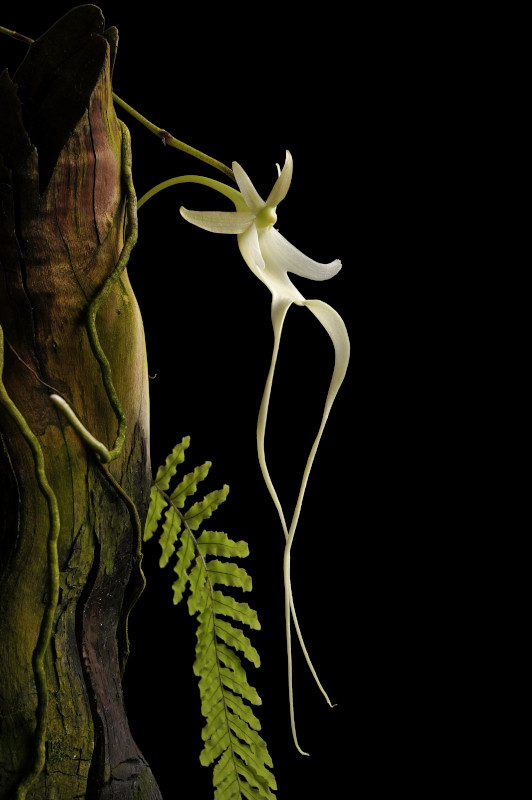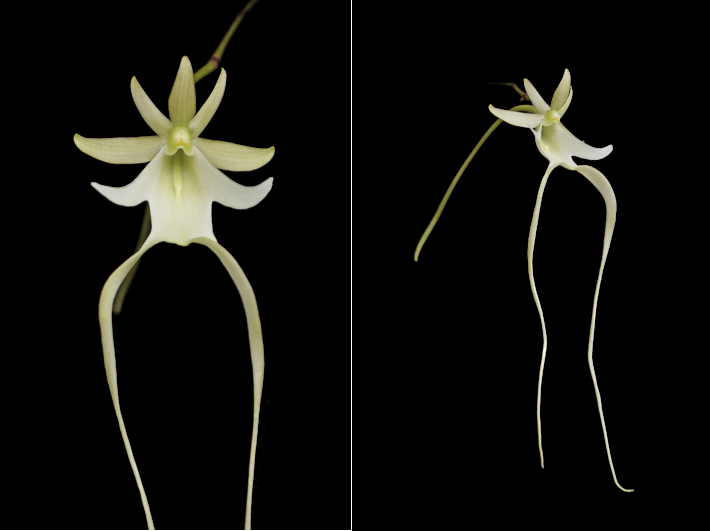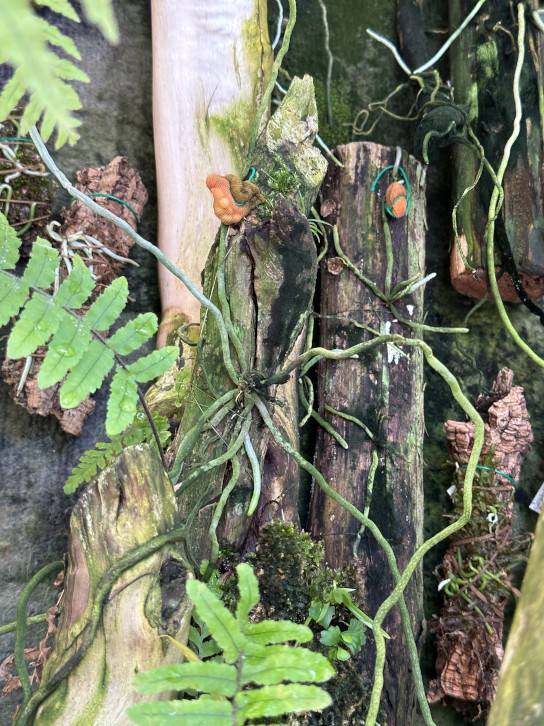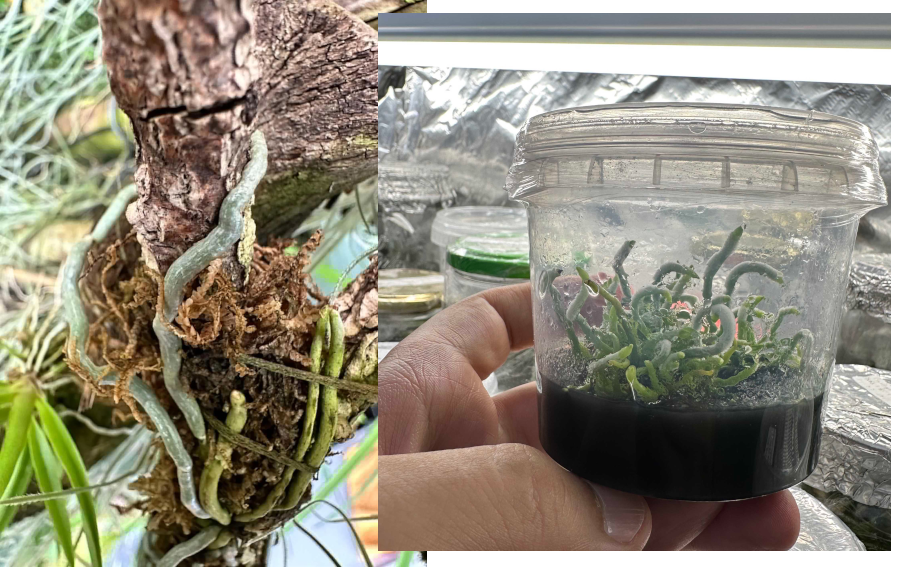Unravelling the mystery of Ghost orchid – Dendrophylax lindenii
Shashidhar Sastry

Among the flowering plants, orchids are known for their beauty and mystic appearance. Orchid family (Orchidaceae) is the largest flowering family with more than 29, 000 species (naturally occurring). There is always a kind of mystery surrounding the orchid flowers owing to their bizarre shape, size and diversity. Some of them mimicking various shapes resembling face of a monkey, (commonly known as monkey orchid belonging to genus Dracula) Tiger orchid (belongs to genus Grammatophyllum,) and lady slipper orchid ( genus Paphiopedilum.). Further, there are orchid flowers resembling insects (Ophrys sp), wasps, bees and even a flying duck (Caleana sp). Our own western Ghats has a well-known species, Cottonia peduncularis resembling the bee. Nature has endowed these orchid flowers with most intriguing shapes, sizes, colours and fragrance which are displayed with one single purpose to attract the pollinators and to propagate itself in nature. Wild orchids or orchid species which grows in nature are specific in their requirements of light, temperature, humidity and nutrients. Often, they have preference for the host tree and nature of bark on which they germinate and grow. It is amazing to see the way they nestle in a particular angle to receive moisture and nutrients.
Among these wonderful species, one such mysterious, finicky and rare orchid stands out with an equally strange name and appearance is “Ghost orchid” botanically known as Dendrophylax lindenii. The name comes after the plant has its roots well camouflaged on the tree trunk and the white blooms projecting as if straight out of nowhere and dangling in the air in a mysterious manner which is a sight to see. The plant attaches and grows on the tree trunk with its greenish grey roots and no leaves. During the months between June and October, the white flower emerges as if from nowhere and keeps hovering in the air as the spike lengthens, the weight of the bud makes a graceful arch. The illusion created by the flowers and the appearance of floating in the air amidst the woods, its leafless nature all results in it being aptly called “Ghost orchid”. This orchid’s popularity is known when one goes through the book “The Orchid Thief” by Susan Orlean. A major motion picture ‘Adaption’ has also been made starring Nicholas Cage.

Ghost orchid is an epiphyte (growing on the trees) and native to Florida (USA), Bahamas and parts of Cuba. It prefers a habitat of high humidity provided by the low-lying swampy conditions where they get attached to smooth bark of royal palm to rough bark of pop ash tree (Fraxinus caroliniana), a deciduous tree. In Florida Fraxinus caroliniana and Annona glabra are the main host trees. These host trees support about 80 % of the orchids in Florida. Whereas in Cuba there are as many as 18 host trees harboring this orchid. Its habitat, Fakahatchee strand preserve State Park (meaning “river with muddy banks” in the Seminole language) in Florida state of USA is the largest swamp spread over 19 miles long and 5 miles wide. It covers an area of 85, 000 acres. The swamp is shallow in depth and often called as “the Grand Canyon of Everglades”. The other habitats are, big Cypress preserves and Panther refuge in southern parts of Florida. These habitats ideally provide all the specific requirements of this orchid in terms of high humidity, low light. Because of these specialised requirements they are also highly vulnerable to any changes in the environment and the present impact of climate changes makes it more complicated.
The plant is unique due to its leafless nature and making it difficult to sight these orchids in its natural habitat. They have roots which are photosynthetically active and nourish the plant. These roots cling to the black bark of the Pop Ash and survive. The orchid has symbiotic relationship with mycorrhiza (Ceratobasidium) right from its germination to growth. Thus, making the host tree equally important as it harbour the mycorrhiza for orchid’s sustenance.

Nature’s ingenuity is at its best when the plants adopts various reproductive strategies to ensure their propagation. Orchid flowers attain diverse shapes, sizes, fragrance and mimics to attract the pollinators and enable them to reproduce. This exceptional orchid has a unique life cycle with a special reproduction method. But, the flowers of Ghost orchid do not have fragrance nor produce nectar to attract the pollinators, they deceptively attract the pollinators. Charles Darwin in his monumental works and observations on pollinators of orchids, observed that a white coloured orchid from Madagascar, Angraecum sesquipedale, is pollinated by moths. Generally, these moths pollinate at night and the sphinx moth has a long proboscis which enables it to reach the flower and also in the process visit several flowers and enable pollination. The Ghost orchid which blooms for a week between June and August is pollinated by variety of hawk moths, such as Fig Sphinx Moth, pawpaw sphinx moth. The flower of Ghost orchid mimics the female giant sphinx moth and attracts the male by deception and as it attempts to mate with the flower, the pollen attaches to the moth and transfers to another flower eventually. However, there is further need to understand the pollination ecology of the genus to save it from the brink of endanger.
The mystery surrounding this orchid has resulted in fascination and the passion to possess this orchid in their collection is one of the main reasons for its declining population in nature. Although this orchid thrives in very inhospitable conditions of murky waters, mosquitoes, snakes, and alligators, it has not deterred the passionate collectors and few with commercial overtures to collect illegally, reproduce and sell. In addition to this, poaching and illegal collection, the ghost orchid is further made vulnerable due to climate change, loss of pollinators, and loss of habitat. Though several conservation measures are being adopted to protect this orchid in its natural habitat, creating awareness to conserve this in its natural habitat is utmost important for its crucial survival.
Majority of world’s orchids are threatened. The main reasons for this are habitat destruction and over collection. The dire consequences of illegal removal of this orchid are disastrous. The ongoing research and data collection work pertaining to this orchid will be lost, especially considering that its natural habitat is limited to few pockets and not much of data on various aspects of the genus is still not available. Plenty of gaps in data exists regarding numerous species especially on pollination ecology. Thus, removing the plant from its natural habitat will not only kill the plant, but a great hindrance to the ongoing research and data collection on ghost orchid. Collecting information on its habitat requirements is very crucial for conservation of this species. It is observed that habitat destruction and hydrologic changes, due to human intervention and hurricanes have resulted in decline in population. Climate change also has its impact on the species survival. With a rise in the level of sea, some of the low-lying natural habitats might be affected.
In view of these threats, there is an urgent need to understand the species and its natural habitat in totality. For orchids the two most important interdependent processes in their life cycle are pollination (survival of pollinators) and germination (presence of mycorrhiza). Understanding ghost orchid’s reproduction in its natural habitat is very essential for effective conservation to plan its propagation and reintroduction efforts.
With human intervention resulting in changes to natural habitats, and impact of climatic changes, ecological data on the pollination of endangered species such as ghost orchid are crucial for planning effective conservation measures.

The ghost orchid is now protected in many public land areas in South Florida, including Big Cypress National Preserve. With continued protection, the ghost and other orchids will continue to inhabit the unique mosaic of ecosystems that is South Florida.
Some of the measures employed for protection of this orchid are. camera trapping methods to document the pollination of D. lindenii. Identifying the pollinators and the conservation in a perspective manner is important. Further, the same method can be adopted for other threatened species of orchids.
There have been some conservation measures through propagation of seed culture and establishing them in simulated natural growing conditions have yielded positive results.
The Ghost Orchid, with its fascinating beauty and mysterious nature, stands as a witness to the Nature’s wonder. In an ecosystem various biota are interdependent, only sustainable practices can ensure maintaining the delicate balance in nature and conserve such wonders of nature for future generations.
Here it is apt to note Darwin’s prediction more than a century ago of pollinator (Hawk moth) – Orchid dependence, more specifically Madagascar Star orchid, he said that “If such great moths were to become extinct in Madagascar, assuredly the Angraecum would become extinct. On the other hand, the extinction of the Angraecum would be a serious loss to these moths” This is true in case of conservation of ghost orchid
Article by Dr K S Shashidhar
Pictures by courtesy of Joao Almeida
References:
1. Anon. www.evergladesfoundation.org/post/ghosts-of-the-swamp-or-the-real-orchid-thief
2. Anon. www.forbes.com/sites/grrlscientist/2019/07/19/chasing-ghosts-in-the-everglades-what-pollinates-the-ghost-orchid
3. Anon. www.kew.org/about-us/press-media/ghost-orchid-flowering
4. Anon. www.nps.gov/bicy/learn/nature/ghost-orchid.htm
5. Anon. wikipedia.org/wiki/Dendrophylax_lindenii
6. Johnson, Lynnaun J A N., Kane, Michael E., Zettler, Lawrence W., Mueller, Gregory M. 2023. Diversity and specificity of orchid mycorrhizal fungi in a leafless epiphytic orchid, Dendrophylax lindenii and the potential role of fungi in shaping its fine-scale distribution. Front. Ecol. Evol. Volume 11 – 2023
7. Mujica, Ernest B., Mably Justin., Skarha, Shannon M., Corey, Laura L., Richardson, Larry W., Danaher, Mark W., Gonzalez, Elaine H., Zettler, Lawrence W. 2018. A comparison of ghost orchid (Dendrophylax lindenii) habitats in Florida and Cuba, with particular reference to seedling recruitment and mycorrhizal fungi. Botanical Journal of the Linnaen Society. Vol. 186, 4, 572-586.
8. Orlean Susan.1998.Orchid Thief. Random House.